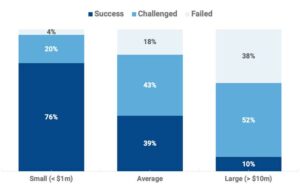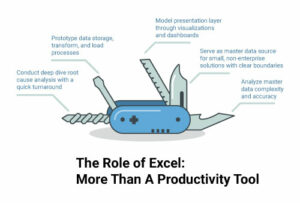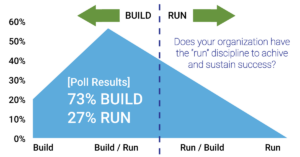The primary reason BI tools are necessary has to do with data volume. Once the number of data records exceeds a million, it becomes difficult to analyze since spreadsheets become slow and unstable. Large data sets require storage capable of scaling. Scalable data storage could be available through the BI vendor’s platform, or you can create a storage solution for easy, on-demand access.
Your business organization should not care which BI vendor is selected. Instead, they should care about leveraging the data it provides to help make better decisions. The practices that matter fit into three buckets:
- Your Dashboard: Have a “check engine” light—a quick and familiar way to understand when you have a problem. Like your car’s check engine light, this needs to be available through a dashboard that is immediately viewable by the right executives. Viewing the light should not require a click or link. If you have a problem, the light turns on without user action. Similar to your check engine light not telling you the diagnostic code, your dashboard does not communicate the specific issue
- Your Data Analysis: Diagnose problems instead of wasting time wrestling data. When a big data set is stored and maintained appropriately, the individual analyzing the problem can extract summary or time-based data sets, allowing for the correct level of analysis. A successful solution allows on-demand aggregation and extraction without a technical request. Drawing conclusions from the data requires the ability to analyze segments of data over multiple time periods. The dynamic nature of analysis and drawing conclusions require the use of spreadsheets.
- Your Decision-Making: Draw conclusions, educate and influence leaders to act. Once your data and root causes are well understood, the art of storytelling takes over. The story must diagnose the problem, support fact-based decisions and outline alternative actions. The individual presenting the information should recommend a path, and typically, leaders will ask follow-up questions that require additional analysis. Your BI platform should accommodate easy access to the data for these follow-up questions.
Does your BI Vendor Support Your Dashboard, Data Analysis and Decision-Making?
The most successful organizations have these three critical areas. Your BI vendor impacts the support and delivery of these three components, and the BI tool itself will not dictate the success or failure of your analysis or decision-making.
Although the dashboard may look slightly different, the check engine light needs to turn on or off regardless of the vendor.
The data segmentation is based on the business model, meaning the data can be delivered securely through a different mechanism.
The storytelling and decision-making process is agnostic to any business intelligence vendor. The facts can be sourced using a different vendor’s tool, but the information should be applied consistently and support the business decision presented to the leaders.












